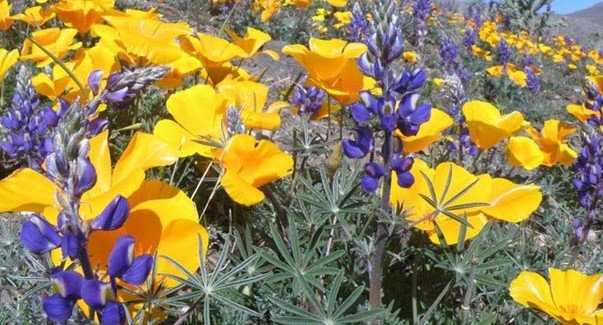Your cart is empty
Wildflowers
This spring’s glorious wildflower show can be re-created in your own garden — be it a flower-filled meadow, a few pots on a patio or balcony or anything in between.

Wildflower gardening may be enjoyed by all gardeners, from beginners to advanced. Wildflowers can also be incorporated into any style of landscape from naturally wild to a more manicured landscape.
With some planning, some cooperative rain and a little patience, wildflowers will provide beautiful blooming color for you, too.
The fall, especially October, is the best time to plant because the winter rain and cooler temperatures encourage germination of the seeds.
The next best time to plant for summer and fall wildflowers is the month of April. The soil temperatures are still cool and the ground is, hopefully, moist from recent rain. Plant a few packets of seed in your garden. You will be so happy to have those bright splashes of color during those long summer months.
Plant where you can have a reliable source of water. Some years, we don’t get enough rain, so supplemental watering is necessary for the seeds to germinate. Some of the seeds may take up to three weeks to germinate. They need to be kept moist. But the seeds sure don’t want to be blasted with a hose-end nozzle that will dislodge them from their beds or expose them to the birds. Either a watering can with a rose or a water wand will work the best to deliver a gentle shower.
Before planting, mix your seeds with potting soil, compost or sand in a ratio of one part seed to four parts filler. This helps distribute the seeds evenly. Sowing your wildflower seeds too thickly causes the seedlings to compete with each other for sun, water and nutrients, resulting in weak and leggy plants.
One method of planting your wildflowers is to sprinkle the seeds directly onto decomposed granite, then use a hose to wash the seeds off the granite and into contact with the soil. If you plant directly in the soil, roughen up only the surface — be careful not to cultivate any deeper than 1 inch. Remember that each square inch of soil contains thousands of weed seeds, most of them waiting for their moment to sprout and grow.
Sow one-half of the seed evenly in one direction, say north to south. Then sow the remainder evenly in an east-west direction. Then go ahead and wash the seed into the granite or press the seed into the soil with the backside of a rake. Don’t bury the seeds. They need the sun to germinate. Some of the seeds may not be buried and that’s OK.
Another really easy way to start a wildflower garden is to plant a few seeds next to established plants that are on an irrigation emitter. Use the water pattern as a guide and just press the seed into the soil. This way, you’ll have wildflowers without having to hand water them. This is a pretty foolproof way to have beautiful flowers. Don’t forget to adjust your irrigation clock to water frequently. After the seeds have sprouted and grown a couple of inches, you will need to reset your clock back for your established plants.
A handy tip is to plant a few seeds of each variety in pots of sterile potting soil so that you will know what the seedlings look like when they germinate. This way, you’ll be sure to pull the weeds, not the flowers.
Weed often. Weeds compete with your wildflowers for nutrients, water and sunshine.
Thin the wildflower seedlings to give them room to grow and develop their wonderful flowers. It’s OK to thin to one plant every few inches.
Another good thing about wildflowers is that you don’t need to fertilize them. Once they are up and growing, just water and enjoy them. Something to remember is that perennial plants started by seed will usually not bloom for the first year. They will bloom every year after that.
If you have wisely chosen plants that are native to the Sonoran desert or are adapted to our climate and soil conditions, they will re-seed in your wildflower garden. Let the seeds ripen for about two weeks after the full-bloom period. Then, you can let the plants reseed naturally or save the seeds in paper bags for later. Or better yet, share the seeds with a neighbor or friend and start wildflowers growing throughout your neighborhood.
When the annual plants have died back, cut them off at ground level. Go ahead and let the roots remain and decompose in the soil to return nutrients to the soil and provide aeration. With perennial plants, cut them back to new growth. Usually, this will spur a new flush of flowers to enjoy all over again.

